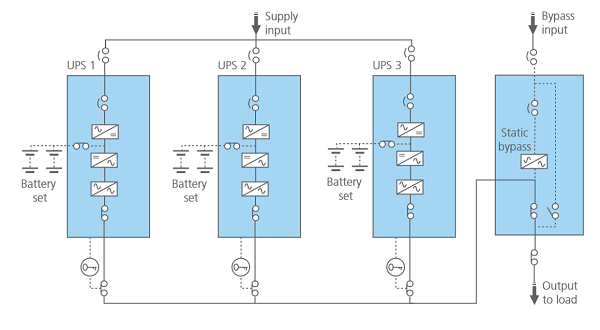Learn the pros and cons of the two main approaches to UPS bypass and gain CPD points with this pair of FREE white papers.
UPS bypass kicks in when an uninterruptible power supply experiences a fault condition, such as an overload or short circuit, or there’s a component failure.
It transfers the critical load from the UPS system and batteries to the mains electricity supply until the problem is solved.
Transferring to static bypass should be considered as a last resort, unless it is for UPS maintenance purposes.
There are two main approaches to UPS bypass:
- Centralised UPS Bypass: incorporates a single common static bypass switch and components housed in a separate bypass cabinet. Rated for the required capacity of the entire UPS system.
- Decentralised (Distributed) UPS Bypass: requires each UPS in the system to have its own internal static bypass switch, rated to the maximum capacity of the individual unit. If they system needs to transfer to bypass, the static switch in each UPS will simultaneously switch on and share the load.
Examples of different UPS bypass configurations:
- N Capacity:
- Centralised system with three 200 kVA UPS = a single bypass switch module rated at 600 kVA
- Decentralised system with three 200 kVA UPS = three separate bypass switches rated at 200 kVA
- N+1 Redundant:
- Centralised system with three 200 kVA UPS = a single bypass switch module rated at 400 kVA
- Decentralised system with three 200 kVA UPS = three separate bypass switches rated at 200 kVA

CPD-Accredited White Papers
We’ve put together a pair of white papers that explore the advantages and disadvantages of both systems. The first document focuses purely on UPS bypass in ‘N’ capacity configurations. The other piece covers ‘N+1’ parallel redundant UPS systems.
These two white papers are also accredited by the CPD Certification Service, an independent body established in 1996 that sets the benchmark in continuing professional development.
What Factors Impact The Choice Of UPS Bypass?
In reality, choosing between either method should be decided on a case-by-case basis according to a few core factors:
- Reliability: there are two issues to consider here – operational resilience and maintenance reliability. With the former, a centralised system does introduce an unappealing single point of failure (SPOF) into the static bypass supply. Maintenance resilience is very much linked to the configuration i.e. in ‘N’ capacity configurations bypass functionality is lost during maintenance in both centralised or decentralised systems. In N+1 installations, decentralised systems ensure redundancy for both the UPS and the bypass, whereas with centralised there isn’t any redundancy for the static bypass switch.
- Power balancing: a big advantage with centralised bypass is that it eliminates issues related to different cable lengths, which makes power balancing during bypass easier. With decentralised systems, the length and impedance of the cables connecting each UPS to the input and output can make it difficult to balance current flow when running on bypass.
- Cost: as a rule of thumb, a centralised bypass is slightly more expensive. This is due to the cost of a standalone cabinet housing the static bypass switch, components, cabling, and controlling infrastructure.
- Footprint and future-planning: a centralised bypass requires additional space and is more restrictive in terms of future expansion. Care must be taken to ensure the bypass module isn’t over or undersized at initial installation. Decentralised bypass offers more flexibility for future growth.
In Summary
Broadly speaking, scalability and lower initial capital costs associated with decentralised UPS bypass make it an appropriate selection for small to medium-sized installations using UPS up to 200 kVA.
On the flip side, the reliability and performance at scale make centralised UPS bypass a logical choice for larger facilities such as data centres, particularly those deploying multiple units of 300-400 kVA and above.



